The Polish capital of Warsaw is one of Eastern Europe’s great and historic capitals, and not many places like this city have experienced so turbulent times. In recent centuries, Warsaw has undergone several divisions and takeovers of power in Poland, and more recently about 85% of Warsaw was destroyed during World War II.
Time and again, the city has been rebuilt, and today the many beautiful buildings of historic Warsaw stand again in their original and noble exterior. The major investment in new construction in recent decades has provided a further dimension with a great architectural mix where the historical and new meet.
Fine museums depict, among other things, the turbulent years of war, but art museums and some of the many mansions and palaces are also worth a visit. There is also a huge selection of shopping and dining options, all with the warm Polish atmosphere and tasy food as the centerpiece.
The Old Town is the historic center of Warsaw, and it remains the center for tourists and locals when old and cozy streets and squares are to be seen and visited. Close to this is the new city, which has its own marketplace. From the 20th century’s post-war rebuilding and expansion of the city you can see the impressive Soviet culture and science palace, which is another city landmark.
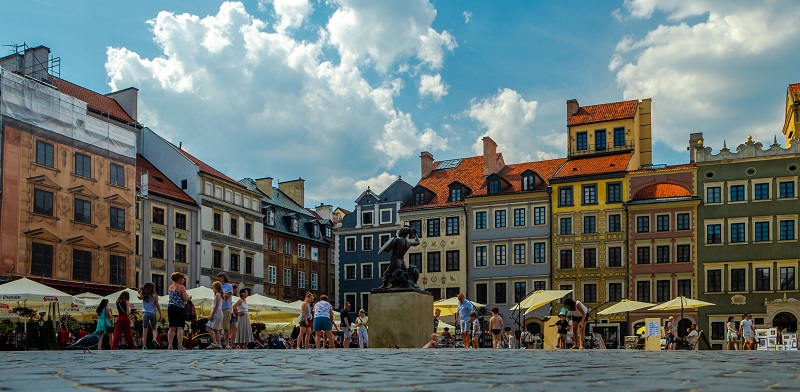
Warsaw’s Old Town is the city’s most cozy area with cobblestones in the streets and beautiful old architecture. Since its construction around the year 1300, the market square has been the center.
The Old Town Market Square was laid out in the 13th century and was Warsaw’s center of trade and politics. Today there is a nice city life on the square with many cafes and restaurants in the beautiful setting.
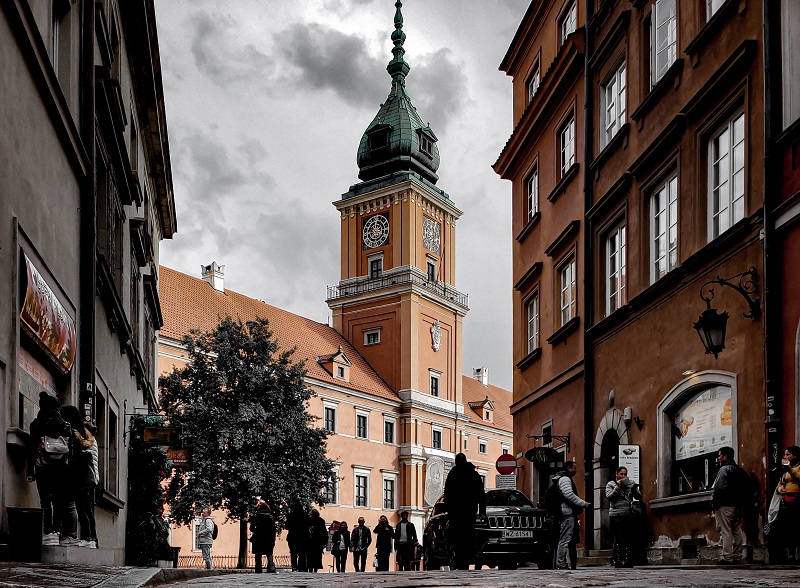
The Royal Palace of Warsaw was first built in the 14th century. In 1569, King Sigismund III moved his residence to the castle, and Warsaw became the capital of Poland.
Barbakan is the old town gate of Warsaw’s northern entrance, and it was an integral part of the city’s defensive walls. Barbakan was built in the 16th century and rebuilt in the 1950s.
This street, along with its southern extension, Ulica Nowy Świat, is two of the city’s most beautiful historic streets. At the same time, they form the first part of the old royal road.
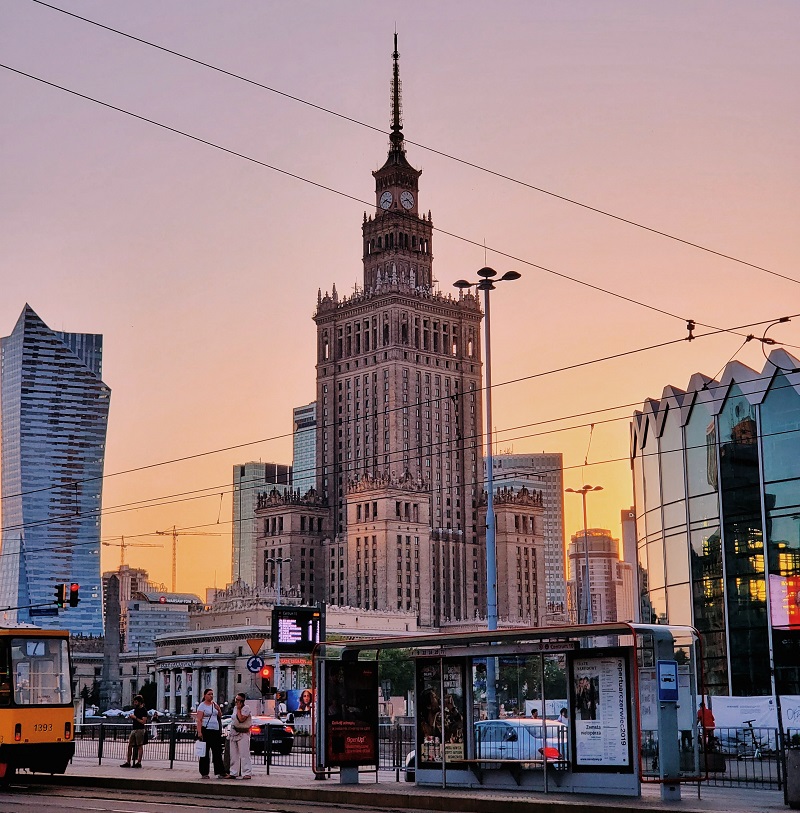
This is an impressive skyscraper and one of Warsaw’s landmarks. The palace was built as a gift from Joseph Stalin and the Soviet Union to Poland and the Polish people in the 1950s.
Fotoplastikon is an installation for the display of three-dimensional images. It was made in the early 1900s ,and it is the only one remaining in Europe of the hundreds that were set up in many major cities.
Lazienki Park is one of Warsaw’s green oases, where the city’s inhabitants come to relax among the many trees and beautiful buildings from the time of the Polish kings or to visit one of the cafes in the park.
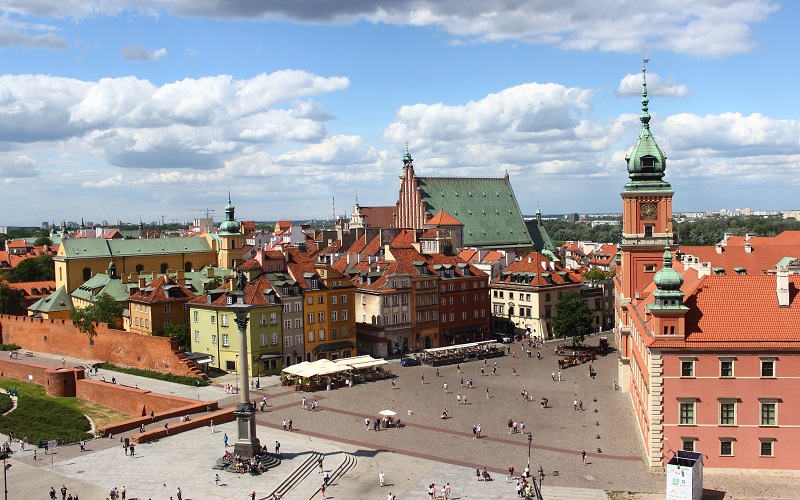
The Palace Square in Warsaw is located at the southern entrance to the Old Town. You can see the 22 meter/72 foot high Sigismund pillar from 1643-1644 on the square. It was erected when the country’s capital was moved to Warsaw.
Warsaw Cathedral was built throughout the 14th and 15th centuries as an ordinary parish church. The building was a typical example of a brick church building in the Mazovia region.
The Warsaw City History Museum is housed in no less than eleven townhouses on the north side of the Old Town Market Square. Here you can see a fine exhibition about the history of the Polish capital.
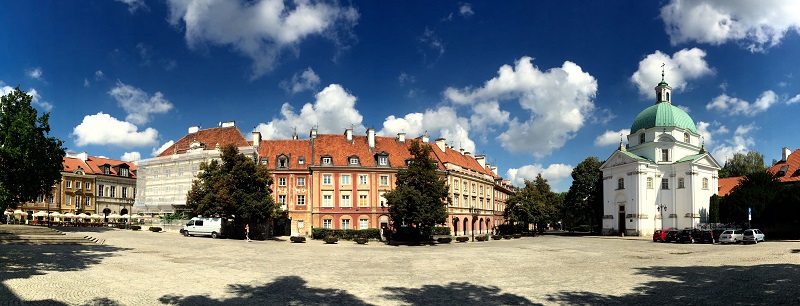
The New Town Market Square is, as the name suggests, a market square in the so-called New Town, and here you can see the beautiful baroque church, St. Kazimir’s Church, from the late 17th century.
This church is the representative cathedral of the Polish army, but its history dates back to the piarists who started construction in 1660.
The Bank Square is one of Warsaw’s large and central squares, and it has been one of the political, financial and cultural hotspots in the city for the past centuries.
This is one of the museums dealing with the colossal consequences of World War II for the Polish people and Warsaw. The name Pawiak refers to the German Gestapo prison in the city in the years 1939-1945.
This palace was built in 1643-1645 as the residence of the Commander of the Polish Army. From the end of the 17th century until 1817, it belonged to the Radziwiłł family, while today it is the residence of the President of Poland.
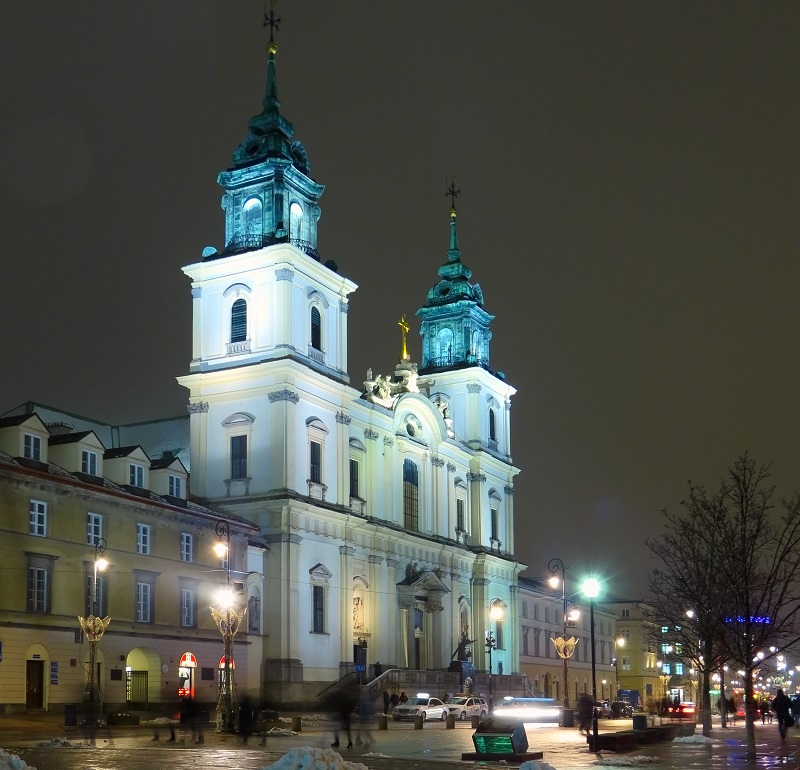
This is one of Warsaw’s most beautiful and impressive Baroque churches. The elegantly decorated façade is one of the characteristic architectural highlights of the Polish royal road, and the interior of the church is also worth seeing.
St. Joseph’s Church, commonly known as the Visitationist Church, is one of Warsaw’s most beautiful churches from the Rococo period, and it stands as one of the characteristic buildings on the stately street, Ulica Krakowskie Przedmieście.
Immediately behind the Tomb of the Unknown Soldier, you can see Warsaw’s first public park, the Saxon Garden, which was laid out in 1727. Today it is one of the city’s popular central places for lovely walks.
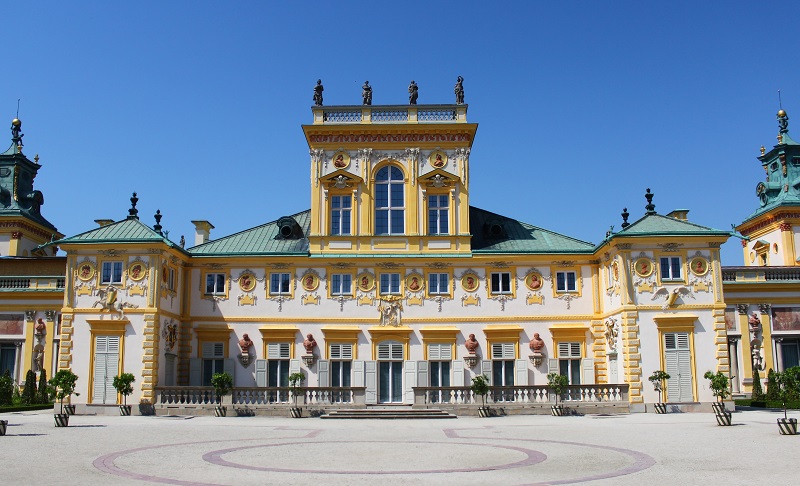
Wilanów Palace is a royal palace located in the Wilanów district just south of Warsaw. It was built as the summer palace of the Polish kings. The palace was built in the current Baroque style in the late 17th century by King Jan III Sobieski.
The small town of Konstancin-Jeziorna is a spa town located by springs of hot and mineral salt water. The water in the city comes from the underground, and the Tężnia facility provides wonderful wellness treatments.
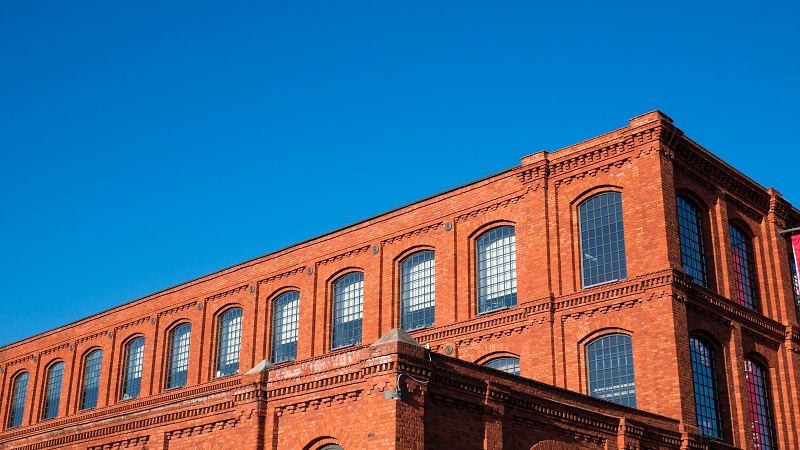
Łódź is one of Poland’s largest cities, it developed and grew relatively late compared to the traditional Polish cultural cities, which is due to a sudden and very large industrial development in and around Łódź in not least the 19th century. There are several things to see from, for example, the Polish industrial architecture.
The village of Zelazowa Wola is the birthplace of composer Frederik Chopin. Here you can visit Chopin’s house, which is part of the Frederik Chopin Museum in Warsaw.
Aleje Jana Pawła II 82
arkadia.com.pl
Aleje Jerozolimskie 179
bluecity.pl
Aleje Marszałkowska 104/122
galeriacentrum.com
Ulica Wołoska 12
galeriamokotow.pl
Ulica Ostrobramska 75c
promenada.com
Ulica Złota 59
zlotetarasy.pl
Ulica Krakowskie Przedmieście, Ulica Nowy Swiat, Aleje Jerozolimskie, Aleje Marszałkowska
Miejski Ogród Zoologiczny
ul. Ratuszowa 1/3
zoowarszawa.pl
Muzeum Kolejnictwa
ul. Towarowa 1
pkp.pl/muzeum
Wodny Park
Merliniego 4
wodnypark.com.pl
Warsaw is a relatively young city in the Polish context. Although there have been settlements on the site where trade routes from north to south and east to west cross the Wisla River, it was not until the 13th century that Mazurian dukes erected a fort on the site where the city’s royal palace is today.
Like the other Polish cities of the Middle Ages, Warsaw was built at the center of a marketplace and with streets facing the gates of a fortified city wall. All these parts of the town plan from that time can be seen in the old town today.
Until 1413, Warsaw was only a village, but when the Mazurian dukes moved their residence to the city, a long period of flourishing began. The city grew rapidly, and it grew to the north beyond the city walls.
However, Poland’s dominant city was in Warsaw’s first centuries Krakow, which was the center of the country both culturally, religiously and politically. Furthermore, when the last Mazurian duke died in 1526 without heirs to the throne, Warsaw was subject to Krakow’s control.
The political turning point and the foundation of Warsaw’s great growth occurred in the following centuries in 1569, when the Polish political administration Sejmen moved to Warsaw in connection with the formation of the Polish-Lithuanian Empire.
In 1596, Warsaw finally came out of the shadow of Krakow when Sigismund III Vasa moved the royal residence from Krakow to the castle in Warsaw. Sigismund III Vasa was a Swede and with the move he got closer to his motherland.
The 17th century was dominated by a beginning weakening for the Polish-Lithuanian Empire, and the country was invaded by Sweden in 1655-1660, where Warsaw was also partially destroyed in the fighting.
Warsaw was rebuilt after the devastation, and it marked the beginning of a long period of growth up through the 18th century, despite the fact that it was here that Poland-Lithuania went down and Poland was split between neighboring countries.
Several mansions, palaces, churches and monasteries were built and the kingdom flourished, especially in the decades before its demise.
At the end of the long growth period, Warsaw had 120,000 inhabitants and it was Poland’s dominant city. By the Polish divisions, Warsaw came under Prussian rule and was reduced to a provincial city.
During Napoleon’s advance towards his eastern goal Moscow, the Duchy of Warsaw was established and the city became the capital. After the Vienna Congress, Warsaw continued for a brief period as its capital until it became part of the Russian Empire – a status that lasted until World War I and the Russian Revolution in 1917.
At the end of the 19th century, Warsaw experienced a period of growth in the industrialization of the country. Among other things, the first railway was opened from Vienna across Warsaw to the residence of the tsar Skt. Petersburg. The city’s population had increased to 680,000 in 1900.
After World War I, Poland was re-established as an independent state and Warsaw became the country’s capital. Within the first 20 years, until the start of World War II, a violent development occurred in Warsaw. Industry, education, culture and science boomed, and the population rose to 1,250,000.
During World War II, Warsaw fell after less than a month of fighting. 1943 was the year of the uprising in the Jewish ghetto, which was destroyed after fierce fighting. Around the arrival of the Soviet army in late 1944, the second uprising began in the city, which, together with the Red Army troops, overcame the German military. The German withdrawal caused enormous losses, with the Germans demolishing many buildings to destroy the city.
World War II cost about 700,000 of the city’s inhabitants, up to 85% of Warsaw’s buildings were destroyed, and after the war there was a tremendous rebuilding work in front of the inhabitants and the new state politically led by the Communist Party.
It was quickly decided to rebuild the city’s old town and other important historical monuments. All the citizens of the city participated, and the business is unique in history, while at the same time building a modern city with infrastructure and lots of new housing.
During the first decades after the war, the most significant parts of the impressive work were completed, and therefore visitors today still experience the charming old Warsaw.
Warsaw is today the capital of a Poland, which since the fall of communism has experienced strong growth in a European Union, with the Polish capital one of the major capitals of Eastern Europe. Modern buildings, shopping malls and other things have shot up, and Warsaw has hosted many, many great events such as the opening match of the European Football Championships in 2012.
Overview of Warsaw
The Polish capital of Warsaw is one of Eastern Europe’s great and historic capitals, and not many places like this city have experienced so turbulent times. In recent centuries, Warsaw has undergone several divisions and takeovers of power in Poland, and more recently about 85% of Warsaw was destroyed during World War II.
Time and again, the city has been rebuilt, and today the many beautiful buildings of historic Warsaw stand again in their original and noble exterior. The major investment in new construction in recent decades has provided a further dimension with a great architectural mix where the historical and new meet.
About the upcoming Warsaw travel guide
About the travel guide
The Warsaw travel guide gives you an overview of the sights and activities of the Polish city. Read about top sights and other sights, and get a tour guide with tour suggestions and detailed descriptions of all the city’s most important churches, monuments, mansions, museums, etc.
Warsaw is waiting for you, and at vamados.com you can also find cheap flights and great deals on hotels for your trip. You just select your travel dates and then you get flight and accommodation suggestions in and around the city.
Read more about Warsaw and Poland
Buy the travel guide
Click the “Add to Cart” button to purchase the travel guide. After that you will come to the payment, where you enter the purchase and payment information. Upon payment of the travel guide, you will immediately receive a receipt with a link to download your purchase. You can download the travel guide immediately or use the download link in the email later.
Use the travel guide
When you buy the travel guide to Warsaw you get the book online so you can have it on your phone, tablet or computer – and of course you can choose to print it. Use the maps and tour suggestions and you will have a good and content-rich journey.
Palace of Culture • The Old Town • Royal Palace • Beautiful Churches • Wilanów
Overview of Warsaw
The Polish capital of Warsaw is one of Eastern Europe’s great and historic capitals, and not many places like this city have experienced so turbulent times. In recent centuries, Warsaw has undergone several divisions and takeovers of power in Poland, and more recently about 85% of Warsaw was destroyed during World War II.
Time and again, the city has been rebuilt, and today the many beautiful buildings of historic Warsaw stand again in their original and noble exterior. The major investment in new construction in recent decades has provided a further dimension with a great architectural mix where the historical and new meet.
About the upcoming Warsaw travel guide
About the travel guide
The Warsaw travel guide gives you an overview of the sights and activities of the Polish city. Read about top sights and other sights, and get a tour guide with tour suggestions and detailed descriptions of all the city’s most important churches, monuments, mansions, museums, etc.
Warsaw is waiting for you, and at vamados.com you can also find cheap flights and great deals on hotels for your trip. You just select your travel dates and then you get flight and accommodation suggestions in and around the city.
Read more about Warsaw and Poland
Buy the travel guide
Click the “Add to Cart” button to purchase the travel guide. After that you will come to the payment, where you enter the purchase and payment information. Upon payment of the travel guide, you will immediately receive a receipt with a link to download your purchase. You can download the travel guide immediately or use the download link in the email later.
Use the travel guide
When you buy the travel guide to Warsaw you get the book online so you can have it on your phone, tablet or computer – and of course you can choose to print it. Use the maps and tour suggestions and you will have a good and content-rich journey.

The Palace Square in Warsaw is located at the southern entrance to the Old Town. You can see the 22 meter/72 foot high Sigismund pillar from 1643-1644 on the square. It was erected when the country’s capital was moved to Warsaw.
Warsaw Cathedral was built throughout the 14th and 15th centuries as an ordinary parish church. The building was a typical example of a brick church building in the Mazovia region.
The Warsaw City History Museum is housed in no less than eleven townhouses on the north side of the Old Town Market Square. Here you can see a fine exhibition about the history of the Polish capital.

The New Town Market Square is, as the name suggests, a market square in the so-called New Town, and here you can see the beautiful baroque church, St. Kazimir’s Church, from the late 17th century.
This church is the representative cathedral of the Polish army, but its history dates back to the piarists who started construction in 1660.
The Bank Square is one of Warsaw’s large and central squares, and it has been one of the political, financial and cultural hotspots in the city for the past centuries.
This is one of the museums dealing with the colossal consequences of World War II for the Polish people and Warsaw. The name Pawiak refers to the German Gestapo prison in the city in the years 1939-1945.
This palace was built in 1643-1645 as the residence of the Commander of the Polish Army. From the end of the 17th century until 1817, it belonged to the Radziwiłł family, while today it is the residence of the President of Poland.

This is one of Warsaw’s most beautiful and impressive Baroque churches. The elegantly decorated façade is one of the characteristic architectural highlights of the Polish royal road, and the interior of the church is also worth seeing.
St. Joseph’s Church, commonly known as the Visitationist Church, is one of Warsaw’s most beautiful churches from the Rococo period, and it stands as one of the characteristic buildings on the stately street, Ulica Krakowskie Przedmieście.
Immediately behind the Tomb of the Unknown Soldier, you can see Warsaw’s first public park, the Saxon Garden, which was laid out in 1727. Today it is one of the city’s popular central places for lovely walks.
Similar to Warsaw Travel Guide